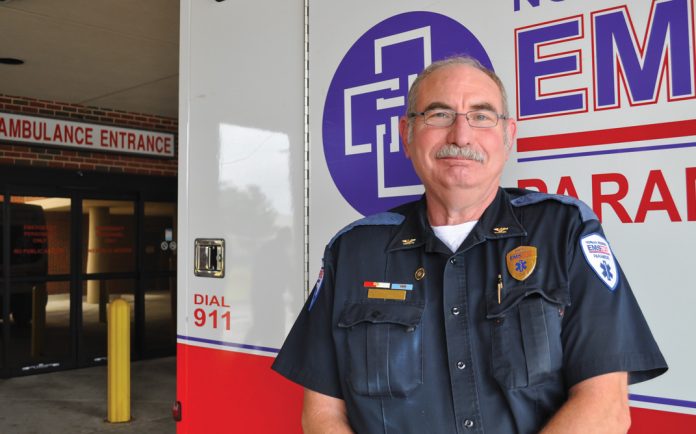story and photos by Bobby Anderson, Staff Writer
For the last four decades Eddie Sims has kept a watchful eye on the citizens of Cleveland County.
You’ll probably never meet him but if you or a loved one ever requires emergency medical attention it will come as a result of the work put in by Sims and his staff.
The EMSSTAT manager and paramedic has around 100 employees who staff the emergency medical services for Norman, Moore, and adjacent rural areas of Cleveland County along with the northern half of the township of Goldsby.
That means Sims’ crew operates 13-14 ambulances on most days and is responsible for the lives of some 200,000 people at any given time.
Then there’s the athletic events.
“Luckily they’re planned,” Sims smiled. “It’s not a summer concert to benefit the tornado victims in the middle of July which I never want to see again.
“We cover the vast majority of OU athletics and a lot of community events in both cities. I live my life around OU. I don’t leave town for OU game days, graduation or medieval fair. There’s things you have anchored and live your life around those.”
When the football season begins and nearly 90,000 people descend on Gaylord Family Oklahoma Memorial Stadium for a daytime game a medical call for assistance comes in every 90 seconds.
Sims grew up in Miami, Florida with older parents. His father was diagnosed with cancer on his spine when Sims was 11.
He took care of his parents from then on.
Growing up in the early 1970s watching firefighters John and Roy man Squad 51 on the hit TV drama Emergency, Sims was hooked.
“During that time was when EMS was born. That’s what I wanted to do,” Sims said. “We used to sit around and watch it. I was used to being up 24 hours a day taking care of (my father) and responding to stuff. My mom had issues to where she really couldn’t do it and I was an only child.”
“I got involved with medicine and helping people before I really had a choice and it was really what I wanted to do.”
When he was old enough to get a job he found the local market tough to break into without a military or minority background.
“They wouldn’t even accept applications so when I was 14 or 15 I started chasing hurricanes,” he said. “In that process I met the director of the severe storms lab (in Norman) who invited us to come chase tornadoes.”
That began a routine where every spring he would fly to Oklahoma to chase storms.
He eventually settled in Norman and was among the first group to establish medical services under the Norman Police Department.
“When we started Norman probably had 50,000 or 60,000 people in it,” Sims said. “The culture in Oklahoma was ‘take me to the hospital now, you people don’t need to be doing anything to me.”
“There was a lot of public education. Being in a police system it was kind of a unique opportunity that a lot of us that had concerns how the police would integrate into an emergency medical system, it turned out to be an absolutely wonderful fit.”
In 1995, the City of Norman shuffled its emergency services and put them under the umbrella of the Norman Regional Health System.
“Again, that was a great opportunity because the resources the health system had were much greater than the city was willing to contribute,” said Sims, whose agency boasts higher than national average survival rates for patients experiencing cardiac arrest. “Medically, in 1978 if you had a heart attack we tried to get you to a hospital. If you had a second heart attack man you were lucky but you didn’t have much heart left and your quality of life went down.”
“If you had a stroke it really wasn’t an emergency because there wasn’t anything anybody was going to do for you.”
Within the last 10 years that all changed.
“We can get you to a hospital and the people in the cath lab can remove the blockage and you can walk out three days later healthier than when you started,” Sims said. “If you have a stroke and .. we take you to a stroke center and two days later you may have no residual effects at all.”
“The difference that EMS and emergency medicine has made over the four decades I’ve been doing this is amazing.”














